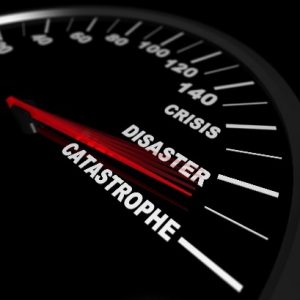 In the last 30 days or so we’ve seen Texas get walloped by a historic monster hurricane Harvey, The Caribbean and Florida get smacked down by Irma and Mexico get rocked by a devastating earthquake. And prior to that, who can forget Katrina or Sandy? We can all learn something from these events: Wherever you live, it’s not a question of whether or not you will experience a disaster, but rather when you will experience a disaster.
In the last 30 days or so we’ve seen Texas get walloped by a historic monster hurricane Harvey, The Caribbean and Florida get smacked down by Irma and Mexico get rocked by a devastating earthquake. And prior to that, who can forget Katrina or Sandy? We can all learn something from these events: Wherever you live, it’s not a question of whether or not you will experience a disaster, but rather when you will experience a disaster.
The Northeast, Mid-Atlantic, Southeast, Midwest, South and West have seen wildfires, earthquakes, hurricanes, super storms, terror attacks, school and workplace shootings, blizzards… I think you get the point, right? It seems like no one is immune anymore. So now that you know it can and will happen to you at some point, what can you do to prepare? What can you do when the power and water stop flowing? Let’s talk about the 5 things you need to do to get organized before a disaster hits so you can be a functional survivor and not just a victim.
1. Know What To Do. In any emergency or disaster, knowing what to do in the first few seconds can mean the difference between life and death. So arm yourself beforehand with the knowledge you need to keep yourself and your loved ones alive. Here are a few potentially life-saving tips:
- Earthquakes– It’s a long-held myth that you should stand in a doorway. The U.S. Geological Survey debunks that on their website. They say doorways are no safer now than other parts of the home and you could get injured by swinging doors or flying debris. They recommend the “Drop, Cover And Hold On” method. That is, drop to the floor, make yourself as small as possible and get under a sturdy piece of furniture like a desk or table. As soon as you can thereafter get out of, and away from, buildings. They can collapse on you in any aftershocks that may follow.
- Hurricanes– Get out of the storm zone as soon as you can when warnings come from government officials or if unable to evacuate, go to a designated storm shelter.
- Tornadoes– Get to a storm shelter or basement as soon as possible. When those are not available, get into a bath tub or closet. Make sure to stay away from windows where flying glass and debris can seriously hurt you. If trapped outside, get into a low-lying area like a drainage ditch.
- Fires– Get to the nearest exit as soon as possible! Leave personal items behind. They can be replaced. Your life cannot. Fires move quickly and seconds matter. Stay as close to floors as possible. In smoke situations, wet a cloth or piece of clothing and cover your nose and mouth. Most who die in fires don’t die from the actual flames, but rather from smoke inhalation.
- Active shooters– The Department of Homeland Security advises that you first try to get out of the building or area. Failing that, hide! Lock or block doors with heavy furniture. Use belts to tie around door return arms to keep them from opening. Dial 911 and let authorities know where you are. If the shooter is nearby, stay as quiet as possible. Text others instead of calling if need be. Silence phones and other devices. Remain calm. As a last resort, when escape is not possible, take action. Act as aggressively as possible. Yell, throw items, use anything you can get your hands on as an improvised weapon. Once you make the decision to act, stay committed to the course and don’t hesitate. Remember, this is a life or death situation!
2. Know What You Need. Food and water are your first priorities. FEMA recommends one gallon of water per person, per day. And you should count on having at least 3 days’ worth stockpiled. That means for a family of four, you should have 12 gallons on hand. Have a supply of non-perishable foods like freeze- dried and canned goods. And make sure each family member has a “Go Bag” stocked with items ahead of time such as a flashlight, batteries, radio, first aid kit, personal toiletries, dust mask, whistle and other essentials.
3. Know Where To Go. Have a designated spot where the family will meet in emergencies. That should consist of a nearby spot and a far spot. The nearby spot would be, say, a tree at the corner in the event of a fire in the home or some other neighborhood spot. A far spot would be a library, place of worship or other easily identified and reachable building outside your neighborhood.
4. Know Who To Call. As part of your go bag you should have a list of emergency contacts written on paper and kept in a zip lock bag to protect against moisture. Cell phones can die from lack of power, water or other outside influences. But paper lasts and can help you once you reach a working cell phone or landline.
5. Practice, Practice, Practice! Rehearse your evacuation, action and escape plans. Know the nearest exits in buildings you frequent such as work and school. Familiarize yourself with your child’s school emergency plans. Coordinate with neighbors and discuss how each can help out in an emergency. Do practice walk-throughs with your family at least once a year for how to evacuate the home or get to your meet-up points.
The bottom line is, prepare! Forewarned is forearmed. Heed warnings and don’t think you’re special. It’s just not worth your life or that of your loved ones. If you do these simple things you can help protect yourself against an ongoing emergency or disaster and the effects afterward. For more help on getting organized for disasters visit our website at www.Org4LifeSolutions.com and sign up for our free newsletter. Follow our blog for regular helpful advice in all areas of life organization. The better organized you are in all respects, the better prepared you will be to meet any and all unexpected events. Good health to you and yours!

